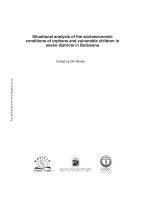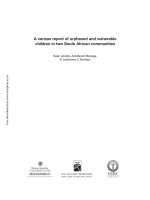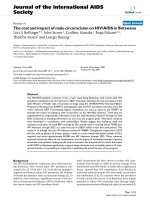Botswana
Bạn đang xem bản rút gọn của tài liệu. Xem và tải ngay bản đầy đủ của tài liệu tại đây (28.33 KB, 3 trang )
Botswana
Botswana is a landlocked country in southern Africa, roughly the
size of Texas. It covers
224,607 square miles, yet contains only 1,444,000 people, making it one
the most thinly
populated countries in Africa. The eastern portion is where most people
reside, because the
Kalahari Desert covers almost all the rest of the nation. Botswana's
climate is a semiarid one,
consisting of very hot summers, and warm winters. Flat and rolling land
make up the topography
of Botswana, with the Kalahari in the southwest.
There are several major ethnic groups in Botswana. Most Botswanans
are black Africans
called Tswana, and the largest group of the Tswana are the Bamangwato.
The Bamangwato
make up almost one third of Botswana's population. The majority of the
Tswana are farmers.
There are also about 10,000 of the San people, or "Bushmen". Some San are
hunter-gatherers,
and some are farmers. Several thousand whites are also included in
Botswana's population. Most
are of British descent. Most whites earn more money then the blacks, and
this causes some racial
tension. Although English is the official language of Botswana, most
people speak Setswana, a
Bantu language. Eighty-five percent of Botswana's people practice
traditional African religions,
while the rest are Christian. Most Botswanan children attend elementary
school, but only fifteen
percent will go on to high school. The small percent of people that go to
college attend the
University of Botswana in Gaborone, the nation's capital.
Great Britain once had control over Botswana. South Africa wanted
Botswana, then
called Bechuanaland, as part of their country. But Great Britain refused.
On September 30,1966,
Botswana was declared independent. It's official name is The Republic of
Botswana. Seretse
Khama became the nation's first president.
Some of Botswana's chief resources are diamonds,copper,nickel, and
salt. The economy
of Botswana was based on cattle and crop raising, but now diamond mining
is controlling the
economy, despite a 25 percent unemployment rate due to slow diamond sales
in 1994. In 1994,
Botswana made 1.8 billion dollars in exports of diamonds,copper, nickel,
and meat. Botswana
has it's own currency: the pula. One pula is equal to about 1.8 U.S.
dollars.
Botswana is run by a parliamentary republic that includes judicial,
legislative, and
executive branches.You must be twenty-one years old to vote. Today,
Botswana's most pressing
problems have to do with disputes between Namibia and Zambia over a small
section of the
border. Also, the twenty-five percent unemployment rate must be lowered.
In conclusion, Botswana is a country that has come a long way, yet
still has a long way to
go. Like every other country, it has it's problems, but Botswana would be
a nice place to visit.









